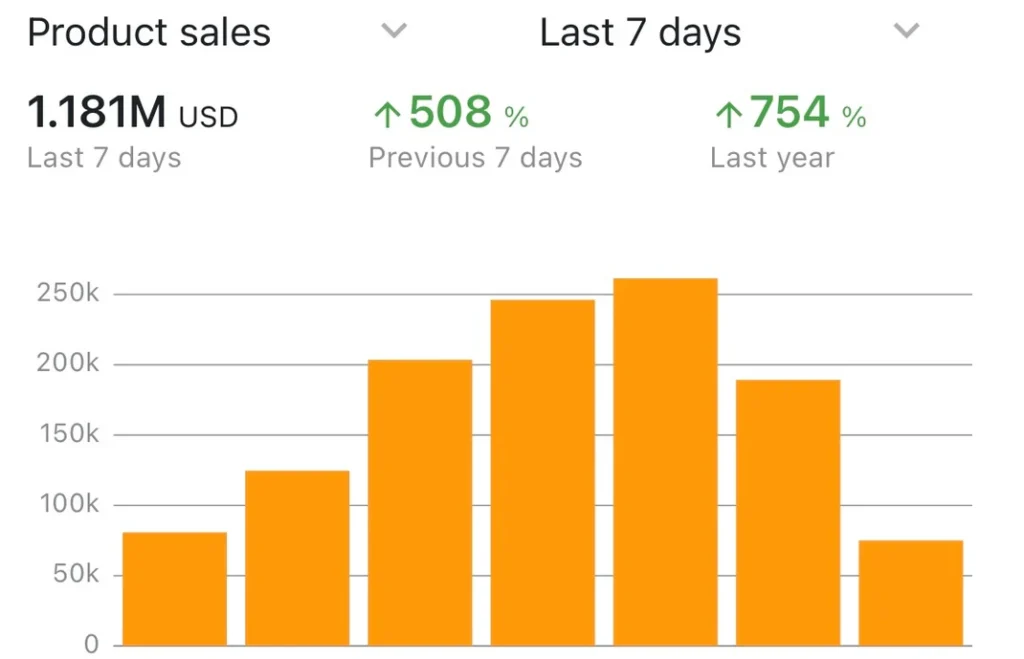7 reasons successful eCommerce sellers opt for funding to fuel growth instead of relying on profits

Cash will forever be king for any successful eCommerce business. Paper profit, though important, is still secondary to operating capital. Running out of cash is still an ever-present risk for successful eCommerce businesses that have been operating for some time now.
Like traditional retailers, successful eCommerce businesses looking to take the next step require funding for working capital, growth, product development, business expansion, risk mitigation, and capital investments.
In this article, we share seven reasons eCommerce sellers place more premium on funding over profits:
1. Rapid growth
Rapid growth occurs when your business grows exponentially within a short period. Often, you did not necessarily plan for such development, catching you off guard. As such, you must be alert to maximize the opportunities available during this phase; nip potential operational inefficiencies in the bud and develop strategies to consolidate the growth.
Some notable operational issues accompanying rapid growth include cash flow shortfalls, customer service issues, and failure to meet customer expectations. Prioritizing profit margins over funding during rapid growth can lead to severe financial constraints. Here’s why eCommerce funding becomes critical in such situations:
Managing increased customer demand
Unplanned increased demand strains resources. Existing inventory levels, fulfillment operations and capabilities, and customer support systems that have powered your success suddenly need to be revised. You’ll need funding to scale these operations swiftly to ensure your business can continue to meet rising demand, customer expectations, and maintain service quality.
This might involve investing in new technology to forecast demand better, getting bigger storage facilities, and onboarding new logistics partners.
Ensuring financial stability and cash flow management
Subscribe to the eCommerce newsletter for
top industry insights
Rapid growth can quickly drain cash and affect your ability to meet your day-to-day obligations. To address increased demand, you’ll have to commit to more inventory and sometimes more marketing before revenue from sales is realized. Getting funding provides the necessary liquidity to make these investments without disrupting your regular cash obligations.
During any rapid growth phase, the likelihood of unforeseen expenses skyrockets – mainly due to supply chain issues. Having cash at hand helps you pay for these expenses without delay.
Inventory and supply chain management
Rapid growth quickly depletes inventory, requiring you to purchase additional stock to avoid stockouts. You may also need to negotiate new terms with your suppliers to ensure you can meet demand swiftly.
You must also expand your supplier base to mitigate risk and ensure you don’t have a single point of failure. Funding for eCommerce sellers is crucial to these activities.
Enhancing technology infrastructure
Exponential growth within a short time strains existing technology infrastructure. Firstly, traffic to your online store may increase beyond the limits you have on your hosting platforms, leading to potential slowdowns or crashes. Every crash or slower loading time has potential consequences, including poor search engine results and prospective customers abandoning your website.
Rapid growth may also require you to invest in new tools to introduce automated workflows into the business, supply chain optimization, and upgrade some of your software tools (like your customer relationship management systems) from free to paid to enjoy the full benefits. Providing funding for technology investments ensures your eCommerce business remains reliable, secure, and capable of handling increased traffic.
Workforce expansion
Increased demand equals more orders and customer interactions across all your support channels. You may need to hire more hands to attend to customer inquiries and complaints. In other circumstances, you may also hire more hands to manage social media and implement some of your needed technological investments. While these positions don’t have to be full-time, they’ll still require additional funding.
Consolidating rapid growth
Beyond meeting immediate operational needs, funding is essential for consolidating rapid growth. This involves stabilizing and optimizing all aspects of the business to ensure long-term sustainability.
It’s important to ensure the business can manage sudden exponential growth. Securing working capital will help support ongoing investments and strategic initiatives, making the business future-proof.
2. Business expansion
The eCommerce space is highly competitive. Once other eCommerce sellers or businesses see your success, you’ll likely see increased competition from copycats and sellers peddling knockoffs. Continuous, strategic growth is one of the ways to stay ahead of the competition.
Planned business expansions are methodological and lead to more sustainable, organic growth. They take longer to bear fruits and typically involve replicating some of the strategies you’re already good at on a much bigger scale. Although planned, organic growth is equally financially demanding. Here are some of the reasons online retailers seek funding for planned expansion:
Expanding to multiple platforms
One primary reason for seeking funding is to expand your business’s presence on various eCommerce platforms, such as Amazon, eBay, and Etsy. Expanding to multiple platforms helps you reach a broader audience. Moreover, each platform has a unique user base and demographics.
For example, according to data from SimilarWeb, the most active age group on Etsy is 25–34 (29.6%). For eBay, the 18–24 age group (39%) makes up the bulk of customers purchasing online. Operating these new platforms requires funding for the fees and marketing that each demands.

Enhancing marketing and brand awareness
Business expansion also requires a matching marketing budget. To attract and retain customers, you’ll need to commit cash to marketing campaigns, search engine optimization (SEO), influencer partnerships, content marketing, and pay-per-click (PPC) advertising.
Funding enables you to devote resources to customer acquisition and your adopted marketing strategies, establishing your brand on the new platform and introducing it to new audiences.
Developing unique selling propositions (USPs)
Another aspect of business expansion that may require funding is developing or deepening your brand’s USP. USPs help you establish a distinct brand identity. Sometimes, it doesn’t have to be grand – for example, customers knowing they can get the most expensive product options from you is a notable USP. So is offering exclusive products; both of these options require substantial funding.
Advantages of developing USPs include:
- Brand positioning
- Competitive edge
- Customer attraction and retention
Diversifying product range
Another example of business expansion is expanding the product range. In this regard, the expansion can be horizontal or vertical:
Popular content
- 14 strategies to improve your eCommerce business’s financial health
- 50+ ChatGPT prompts to elevate your eCommerce business
- A guide to pricing your product on Amazon
- 5 marketing metrics all eCommerce businesses should track
- All about Amazon PPC
Vertical means exploring a specific product more deeply by offering differing variants, such as colors, flavors, and sizes. For example, increasing the number of cookie flavors from 2 to 7. Horizontal expansion means increasing the types of products you sell. For example, you may previously be catering to only dogs but now expand to serve cats, taking your number of SKUs (stock-keeping units) from 5 to 10.
For this part of the expansion, you must conduct market research, perform competitor analysis and demand forecasting, execute reasonable marketing campaigns, pay for development and manufacturing costs, and potentially add more inventory storage solutions. Funding is essential to cover these costs and ensure that the diversification is successful.
Might also interest you:
- 4 key eCommerce funding challenges and how to overcome them
- eCommerce funding: which option is right for you?
- 6 questions to ask yourself before choosing eCommerce financing
Case study: How funding helped DAVAN Strategic implement its growth plan

The team at DAVAN Strategic had a plan to take their eCommerce business from 6 to 7-figure revenue. Some of the critical elements of this plan included placing large inventory reorders and deepening distribution across multiple Amazon fulfillment centers to reach more customers geographically.
However, funding was a major stumbling block. Moreover, traditional funding mechanisms like merchant cash advance and revenue-based funding are often rigid in approach; that is, there’s little wiggle room to accommodate unforeseen circumstances common with eCommerce supply chains.
The team at DAVAN Strategic found 8fig, a reliable eCommerce funding partner. Beyond providing capital for DAVAN Strategic’s Growth Plans, 8fig added technical expertise by providing access to sophisticated financial planning tools.

Thanks to 8fig’s cash injection and AI-based tools, DAVAN Strategic increased revenue and profitability within a short amount of time. With 8fig, you can access flexible funding tailored to your unique eCommerce business operations, including a personalized remittance schedule and adjustable payment plans.
3. Improved cash flow management
Cash is both a catalyst and defense for every eCommerce business. Effective cash flow management ensures that you have sufficient liquidity to meet your day-to-day operational expenses, invest in growth opportunities when they arise, and provide a buffer against market fluctuations and supply chain disruptions.
Cash flow is an immediate indicator of a business’s financial health. An eCommerce business without cash is at the cusp of failure, irrespective of how profitable it is on paper.
Handling seasonal fluctuations
Many eCommerce businesses experience seasonal sales peaks during holidays or special events that require additional funding. For example, the period between Black Friday and Cyber Monday requires significant upfront investment in inventory, marketing, and staffing to handle the increased demand.
Securing funding helps you prepare for these spikes and dips without straining your cash balance, allowing you to capitalize on these opportunities more effectively.
Managing operational costs
Day-to-day operational expenses – such as inventory, marketing, and shipping costs – can strain cash flow, especially for eCommerce ventures in a growth phase. Access to funding ensures that these essential expenses are covered for the immediate future, allowing operations to continue to run smoothly.
Three benefits of effective cash flow management:
- Stability and predictability: Capital injection improves the business outlook and provides financial stability and predictability. Knowing your cash balance is enough to last X months enables better planning and forecasting.
- Increased flexibility: Better cash flow management gives you greater flexibility to respond quickly to market changes, invest in new opportunities, and navigate economic downturns. Think of the pandemic period and how some businesses were better equipped to cope because they had cash or access to funding. Some pivoted to new products, and most had to reconfigure their operations.
- Enhanced investor confidence: We mentioned earlier how cash flow is an immediate health check for any eCommerce business. External investors also check a business’s cash flow statement to assess its prudence and ability to manage cash effectively. So, it’s essential to know when to seek external capital to improve cash flow.
4. Competitive advantage
Forward-thinking eCommerce business owners use funding to transform their online stores. Securing financing is a strategic move that allows you to invest in various areas that can create and sustain a competitive edge. Examples of such areas include:
Capital investments
Capital investments like buying equipment and new tools can turbo-charge your productivity, improve your efficiency, and help you lower production costs in the long run. Such investments can also upgrade your product quality. Here’s one of our favorite success stories:
Case study: Pupsentials skyrocketed after investing capital in high-end machines

Pupsentials sells hand-made, hyper-detailed custom embroidery of dogs. Despite hiring more hands, the production process was slow and tedious; they struggled to meet orders. They knew they had to get more special Japanese embroidery machines valued between $40,000 and $50,000 each.
Jake, the business owner, obtained flexible external funding from 8fig to purchase multiple machines. This allowed them to process more orders quickly, boosting their brand perception, product quality, and, ultimately, sales as well. Sales jumped from $20,000-$50,000 to $100,000-$200,000 in consistent monthly sales. The new investments help Pupsentials cement their position as a market leader in their niche.

This success story highlights how capital investments can help an eCommerce company gain a competitive advantage through increased execution speed and productivity.
Innovation and product development
Limited cash can inhibit a business’s ability to innovate or develop its product range. Product development needs substantial funding for success. Funding enables you to invest in research and development to create unique products that meet emerging customer needs or solve existing problems in novel ways.
This innovation can take the form of new product lines, improved product features, or entirely new product categories that set the business apart from its competitors.
Case study: Ampere leveraged funds and successfully launched new products

Take Ampere, for example. Its founders leveraged funding from 8fig for their eCommerce stores so they could focus on product development and customer growth. This ensured that day-to-day operations did not suffer and the founders could focus their energy on the big picture.

With support from 8fig, Ampere developed new products and increased revenues by $3 million in 12 months. By continuously evolving its product offerings, Ampere could attract and retain customers, ensuring long-term growth and market relevance.
5. Risk mitigation
Various unpredictable factors, like market fluctuations, supply chain disruptions, technological changes, and economic downturns, can threaten the stability and growth of any eCommerce business. Funding can help businesses mitigate these risks in many ways, including:
Revenue streams diversification
We’ve talked about business expansion earlier, and this is similar. Funding facilitates product development and product range expansion. The reality is that relying on a single product line or market can be risky. Changes in consumer preferences, government policies, or economic conditions can adversely affect sales.
As such, diversification and targeting new markets or audiences spreads the risk and reduces the impact of any single adverse event on your business’s overall financial health.
Financial buffer during economic downturns
Funding provides a financial cushion to withstand economic downturns. Additionally, many businesses have inherent volatility, which means they may need temporary funding to manage cash flow and cover operational expenses during periods of low revenue.
Beyond providing financial stability, economic downturns also present opportunities that funding allows you to capitalize on. This is what makes 8fig unique – providing flexible funding that’s adaptable to the business’s inescapable ups and downs.
Improving supply chain resilience
Many factors can disrupt your entire supply chain, including natural disasters, geopolitical tensions, health outbreaks, government policies, and poor logistics partners. Such interruptions can severely affect your ability to fulfill orders and maintain customer satisfaction. Strengthening your supply chain resilience is one way to mitigate potential supply chain issues.
Funding helps you establish relationships with multiple suppliers, invest in advanced logistics technology, build a commodity management structure, increase buffer capacity, and choose suppliers closer to home – even if more expensive.
6. Guaranteed peace of mind
We’ve discussed numerous factors that can disrupt eCommerce businesses, including cash flow shortfalls and fluctuating market conditions, and how funding can help you mitigate some of these risks.
One primary way funding provides peace of mind is by ensuring financial stability. With sufficient capital, you can maintain a healthy cash flow that is enough to cover operational expenses like inventory procurement and marketing campaigns. This financial cushion allows you to operate with limited hiccups, even during periods of lower-than-expected revenue.
Additionally, funding allows you to invest in necessary infrastructure and technological upgrades without worrying about budget constraints and their effect on everyday operations. Making these investments will help you provide a better customer experience, minimize operational disruptions, and maintain competitive advantages. Furthermore, funding helps you respond to unforeseen challenges and opportunities better. In either case, having access to funds means you can act swiftly and decisively without fretting.
Ultimately, the peace of mind that comes with financial security allows you to focus on long-term strategic planning, innovation and product development, and growth.
7. Restructure existing debt
Successful eCommerce sellers may also prefer funding to profits to restructure existing debt from Amazon Lending or Shopify Capital, for example. This could be to enjoy lower interest rates, extended repayment periods, or more manageable payment schedules.
One primary benefit of debt restructuring is reducing interest expenses. Sellers can reduce their overall debt burden, freeing up capital that can be reinvested into the business by lowering interest rates. Debt restructuring also helps with cash flow management. Extended repayment terms and lower monthly payments provide sellers with greater financial flexibility to manage their finances.
Takeaway: Funding is key to sustained eCommerce growth and stability
Prioritizing funding over profits is essential for successful eCommerce sellers aiming to scale. Securing external capital facilitates rapid growth, planned business expansions, and effective cash flow management – ensuring operational stability and enabling competitive advantages. Strategic funding provides the financial security and flexibility you need to thrive and sustain long-term growth in a dynamic and competitive market.
Are you making over $100k annually and need flexible and bespoke funding for your eCommerce business? At 8fig, we understand the unique challenges eCommerce sellers face, so we offer comprehensive funding solutions tailored to your needs. With 8fig, you receive funding precisely when you need it, and our flexible Growth Plans can be quickly adjusted to align with the evolving demands of the eCommerce industry. 8fig covers your entire supply chain expenses for each batch of order (we call them ‘Cycles’) – manufacturing, logistics (shipping and storing), and marketing.
Let us help you scale your eCommerce business with the funding you need.
Have article ideas, requests, or collaboration proposals? Reach out to us at editor@8fig.co – we’d love to hear from you.
Subscribe to the eCommerce newsletter for
top industry insights
to our blog
Read the latest
from 8fig

AI is quietly reshaping eCommerce. Karma’s Hadas Bar-Ad explores how today’s sellers are using intelligent tools to streamline operations, boost efficiency, and drive smarter growth.

WhatsApp isn’t just for memes and group chats anymore. With a 98% open rate, it’s the secret weapon your eCommerce marketing strategy might be missing. Here’s how to do it right.

Stuck with extra inventory after Amazon’s Spring Sale? Learn five smart strategies to clear unsold stock, boost cash flow, and avoid future overstocks with smarter inventory planning.